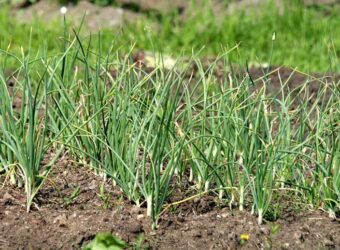Tomatoes taste better right out of the garden. Unfortunately, a lot can grow wrong from seed to mouth. Here is a guide to the most common tomato diseases to help you have a wonderful harvest.
I’ve written an in-depth guide on how to grow tomatoes that you might want to check out!
Caused by Fungal Pathogens
Fungal pathogens cause more problems in tomatoes than any other organism. Here are the common fungal diseases that attack tomatoes.
1. Alternaria Stem Canker
Causes
Alternaria alternata f.sp. lycopersici
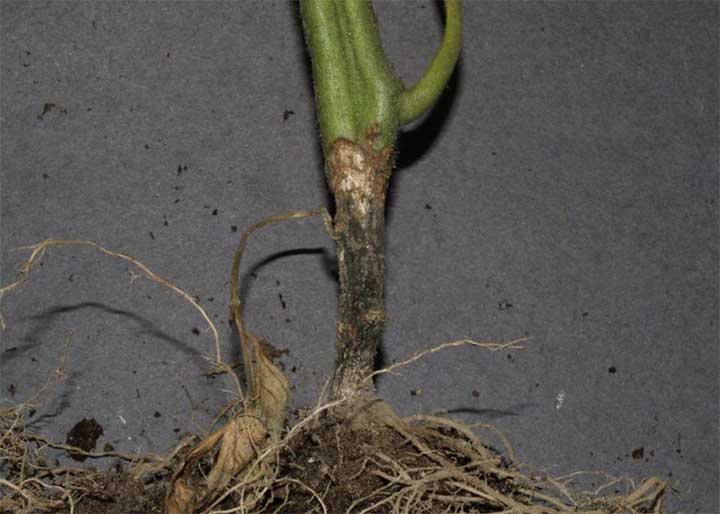
Alternaria stem canker lives in infected tomato debris and the soil. It becomes windborne or is splashed on the plant when it is watered. The spore requires a wet leave to grow. Heavy dew, overhead irrigation, and rain are the primary causes of the problem.
Symptoms

Large brown lesions with pronounced concentric rings form on the stems of the tomato plant. Dark brown or black spots between the veins of leaves are due to a toxin the fungus produces.
Irregular brown spots appear on the fruit with a yellow/green halo around the spots. Eventually, the stem lesions spread and girdle the stem, killing the plant.
Treat
I use fungicides containing mancozeb by spraying them five to six weeks before the anticipated harvest date for my tomatoes, then again in 18-20 days.
I have found that sprays once the problem causes symptoms are ineffective.
Prevent
The easiest way to prevent the problem is to plant resistant varieties. Use straw or hardwood mulch around the plant to cover the soil. Remove all tomato plant debris after the season is done.
Do not get the foliage or stem wet when watering. Use drip irrigation or a soaker hose or water at the root zone. Water in the morning so if the foliage does get wet, it will dry before nightfall.
2. Anthracnose
Causes
Colletotrichum phomoides
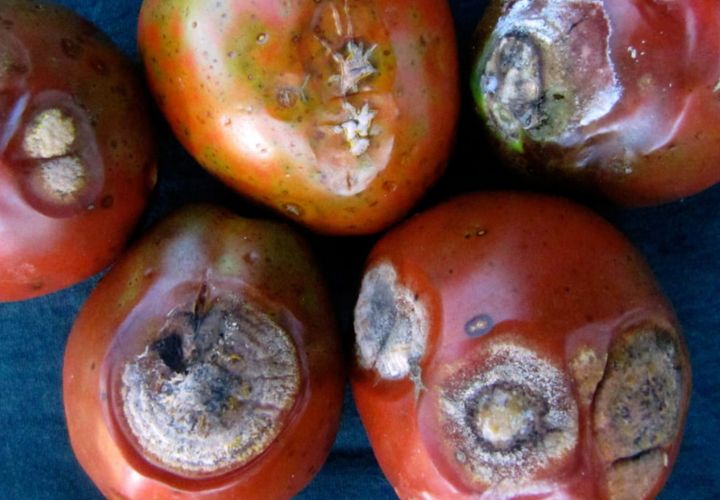
The fungus lives in the soil for up to three years. It is splashed up on the fruit by rain, overhead irrigation, and when you pick wet fruit. Anthracnose is worse with warm rainy weather, overhead irrigation, and heavy defoliation because of early blight. Small wounds on the tomato plant will also allow anthracnose to infect the plant.
Symptoms
This disease affects ripe fruit. Problems with green fruit are rare. Small, sunken, circular spots appear on the ripe fruit. These spots enlarge to ½ inch. Older spots have a black center. Multiple spots occur which are sometimes invaded by other fungus or bacterial infections, and the fruit is rotted completely.
Treat
I treat anthracnose with Bonide Captain Jack’s Copper Fungicide. It and many other copper fungicides are labeled for use in organic gardening, and that is what I do.
Prevent
I harvest my tomatoes as soon as they are ripe. I never use overhead irrigation and make sure I don’t get the foliage or fruit when I water. I use a soaker hose, but drip irrigation also works. Mulch with hardwood mulch or straw to cover the soil. Experts say not to grow tomatoes where anything in the deadly nightshade family has grown in three years.
3. Black Mold
Causes
Alternaria alternata
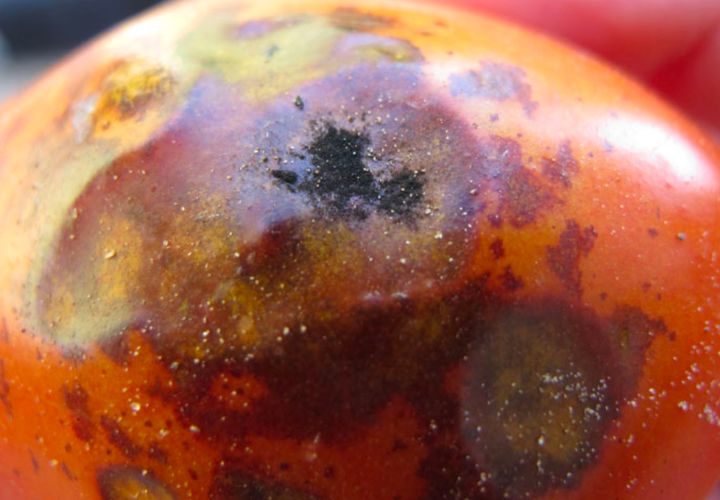
Black mold usually appears after four to five days of rain. The spores need three to five hours of wetness on the fruit to germinate. Sunburn or other wounds increase the likelihood that black mold will attack the fruit.
Symptoms
Light to dark brown lesions form on the fruit. These may just damage the skin, or they may penetrate and damage the whole fruit. During warm humid weather, black spores form a velvety layer on the lesions.
Treat
I treat with Bonide Captain Jack’s Copper Fungicide four to six weeks before the harvest. Two sprays may be necessary for late harvests and after prolonged rainy weather.
Prevent
Do not use overhead irrigation. Harvest the fruit as soon as it is ripe.
4. Botrytis Gray Mold
Causes
Botrytis cinerea
Botrytis gray mold is spread by rain and the wind. It affects all parts of the tomato plant. This mold infects a wide variety of vegetables and can spread from them to tomatoes or vice versa. It needs four to six hours of wetness to germinate on the plant or fruit. Cool weather (65-73 degrees) also favors the disease, especially if there is a lot of rain during this period.
Symptoms
Botrytis gray mold forms a dense velvety brown spore mass. When the area is disturbed, a cloud of spores rises off the area.
On stems and leaves, the lesions are tan to brown. They infect pruning wounds, leaf scars, and cracks. The stem lesions may spread and girdle the plant, causing wilting above the infection.
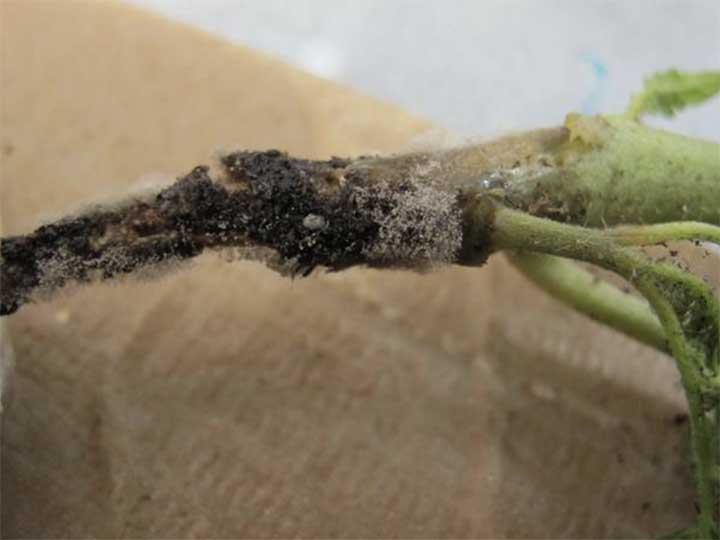
On fruit, the problem causes a whitish soft rot on the tomato. Often, the center skin ruptures allowing the spores into the fruit. Flowers are very susceptible, and the spores may spread to the area where the flower attaches to the stem or to the fruit.
Small whitish rings on fruit are called ghost spots and may reduce the marketability of the tomato.
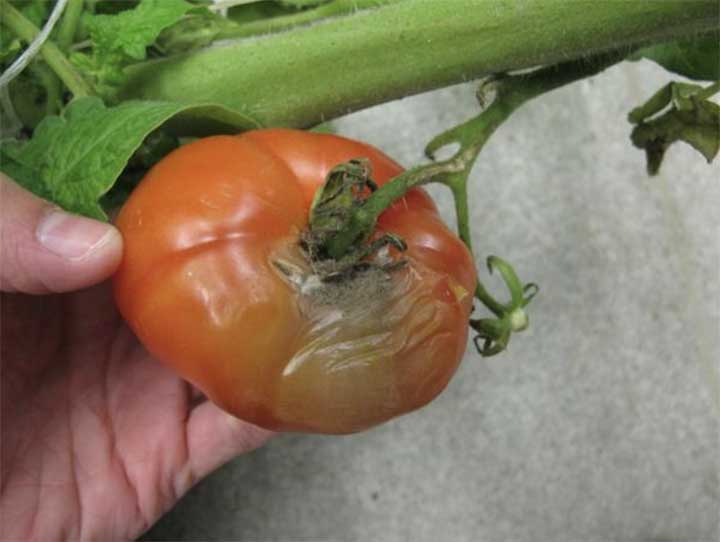
Treat
You can treat botrytis gray mold with Marrone Bio Innovations Regalia CG Quart, but it is very expensive and would only be worth it if you have a lot of tomato plants.
A more economical solution, and the one I use, is Bonide Captain Jack’s Copper Fungicide. One of the good things about this fungicide is that it is listed for organic use and kills a wide variety of diseases.
Prevent
Don’t use overhead irrigation. I use a soaker hose or drip irrigation to direct water to the root zone without splashing dirt on the plants. Don’t work on wet plants. I wait to prune my tomato plants until early afternoon when the plants are dry. Keep the area around your plants free of leaves and plant debris. Keep your plants as healthy as possible so they can resist the disease better.
5. Collar Rot
Causes
Alternaria linariae
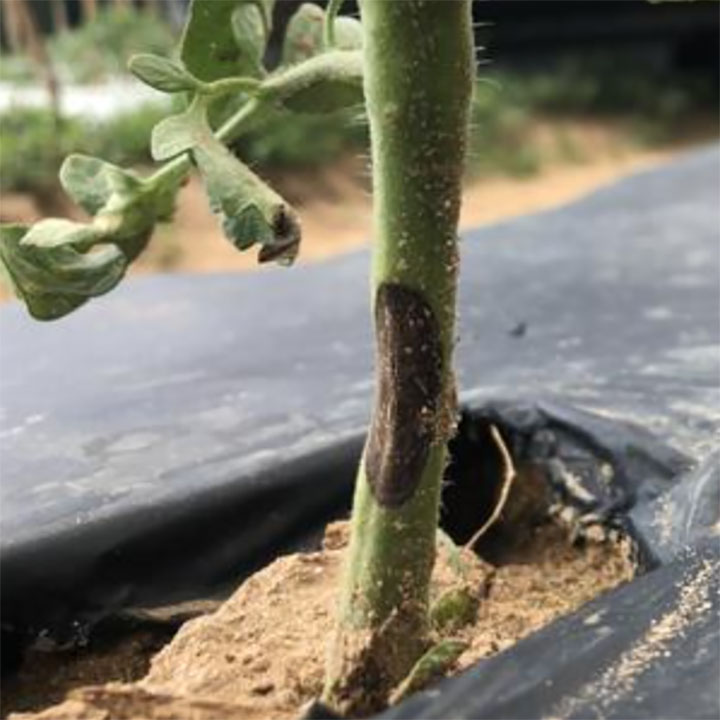
This is the same disease-causing fungus that causes early blight but attacks the stem in collar rot. Collar rot spores survive in the dirt for two to three years and infect the stem when water splashes soil on the stem.
This disease often attacks seedlings which spread collar rot to other plants, including potatoes and chili peppers, when transplanted.
Symptoms
Collar rot causes large, irregular black lesions that appear sunken and may or may not have concentric rings. The lesions expand until they girdle the tomato stem and kill the plant. The spores are dark brown to black.
Treat
If caught early, I bury the stem to over the collar rot and the plant may recover. Otherwise, I spray the area with Bonide Captain Jack’s Neem Oil. Be sure to follow the heat restrictions on the label or the neem oil will burn the plant.
Alternatively, you can use Bonide Captain Jack’s Copper Fungicide. Copper fungicide will not eradicate the rot, but it can control it.
Prevent
Plant varieties resistant to early blight. Use certified disease-free seeds and transplants. Avoid overhead irrigation and remove weeds from around your tomatoes. Avoid handling wet plants.
6. Early Blight
Causes
Alternaria linariae
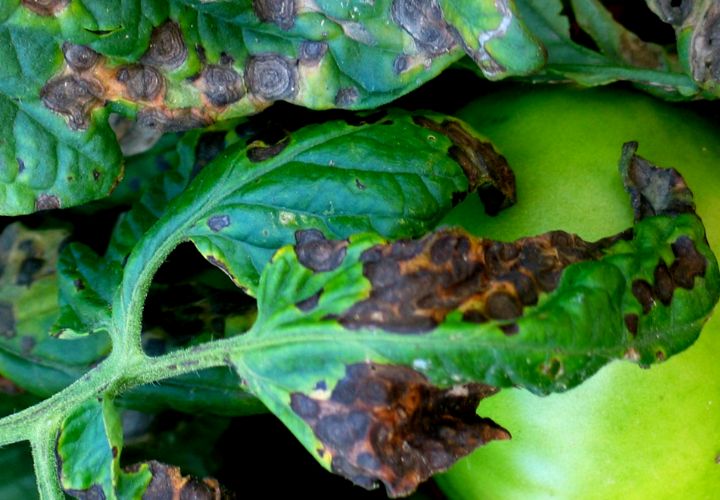
Early blight overwinters in the soil and is spread when rain or irrigation splashes soil containing the spores on a plant. The disease can also spread by wind, meaning it can infect tomatoes, potatoes, peppers, and other deadly nightshade plants during periods of rain or heavy dew.
Alternaria can germinate when the temperature is 47-90 degrees F, and there is free water on the plant. The disease can also germinate when the relative humidity is 90 percent or above.
Symptoms
Small, circular brown lesions appear on the lower leaves of the tomato. They grow to about ½ inch in diameter. As the spots grow, they often have target-like concentric rings, and a yellow halo forms around them. If the leaves are severely affected, they turn brown and drop off, or the dead leaves stay on the plant.
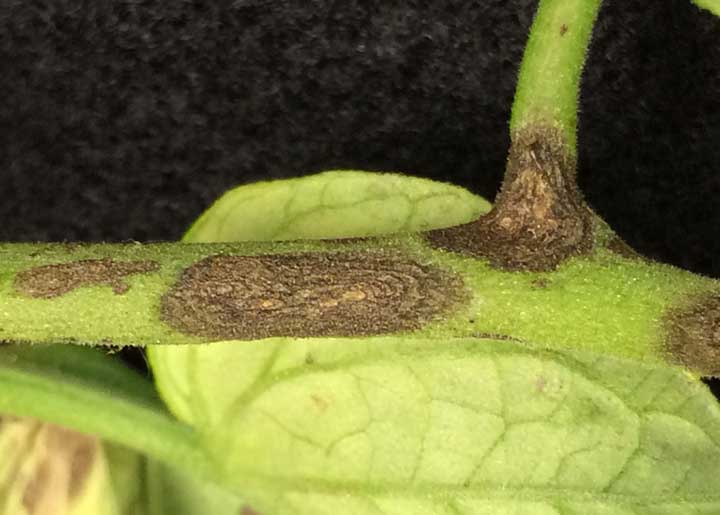
Stem infections are oval, dry, and brown and have concentric rings.
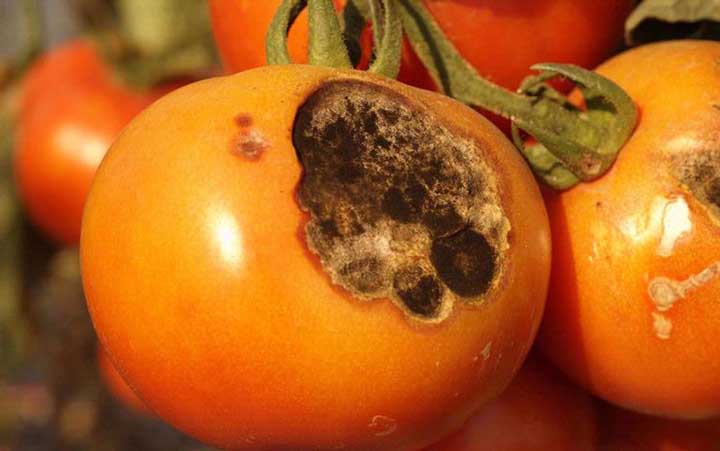
Fruit lesions are leathery and black and have raised concentric ridges. They often occur close to the stem and may cause the tomato to fall off the vine. In plants defoliated by early blight, sunscald on the tomatoes often becomes a problem.
Treat
Pinch off infected leaves and discard them in the trash. Do not remove more than a third of the leaves on the tomato plant.
If you handle an infected plant, wash your hands with soap before touching another plant. If you use tools on an infected plant, wash and sanitize the tools before using them on another plant. You can sanitize the tools by soaking them in a solution of nine parts water and one part bleach for thirty minutes, then rinsing them off.
Most home gardeners who plant varieties resistant to early blight do not need to use fungicides. Plants can tolerate a lot of early blight without reducing the number of tomatoes they produce.
Prevent
Plant tomato varieties resistant to early blight. Use only seeds or transplants that are certified disease-free.
Remove debris from the garden each season. Water the plant with drip irrigation, a soaker hose, or careful hand watering so soil and water do not get on the foliage.
Mulch around the plant with straw or hardwood chunks to cover the soil. You can prune the lower leaves to keep the soil from splashing on leaves.
You should not plant tomatoes or any deadly nightshade plant in the same location for two years after growing any of them.
Increasing the airflow through staking or caging the plant and pruning it will help dry the leaves before the spores can germinate on them.
7. Fusarium Wilt
Causes
Fusarium oxysporum f. sp. Lycopersici

Fusarium wilt is a very common and severe disease. Fusarium wilt lives in the soil and infects the plant through the roots. It clogs the vascular system, eventually stopping the flow of water and nutrients to the area above the clog.
There are three races of Fusarium wilt, races 1,2, and 3. The spores can remain viable in the soil for over ten years. Fusarium wilt is usually brought into the garden in infected soil or on tools that have been used on an infected plant.
For the spores to germinate, the soil needs to be a pH of 5.0-5.5, be warm, and have high humidity.
Symptoms

Initially, leaves wilt during the hottest part of the day but recover at night. Leaves then turn yellow, sometimes only on one side or branch. The entire plant eventually turns yellow and wilts. The leaves do not usually turn brown but stay yellow. Cutting open the stem near the soil will show the vascular system is brown and discolored.
Treat
There is no treatment for Fusarium wilt. Remove affected plants promptly and place them in a plastic bag, then place the bag in the trash. Do not compost affected plants.
Prevent
Plant tomato varieties that are resistant to the race of Fusarium wilt in your garden. If you do not know what race there is, submit soil samples to your plant pathology lab to find out.
Resistant varieties may have spores present but not get infected. Just because your plants don’t show infection doesn’t mean it isn’t there.
Avoid excessive nitrogen fertilizer as it worsens the problem. Make sure any seeds or transplants you buy are certified disease-free. Rotate deadly nightshade plants for 3-5 years to reduce the spores in the soil.
Control weeds near your tomato plants. In acidic soils, raising the pH to 7.0 will help control the disease. Wash hands and sanitize tools after you do anything with a sick plant.
8. Fusarium Crown and Root Rot
Causes
Fusarium oxysporum f. sp. radicis-lycopersici (FORL)
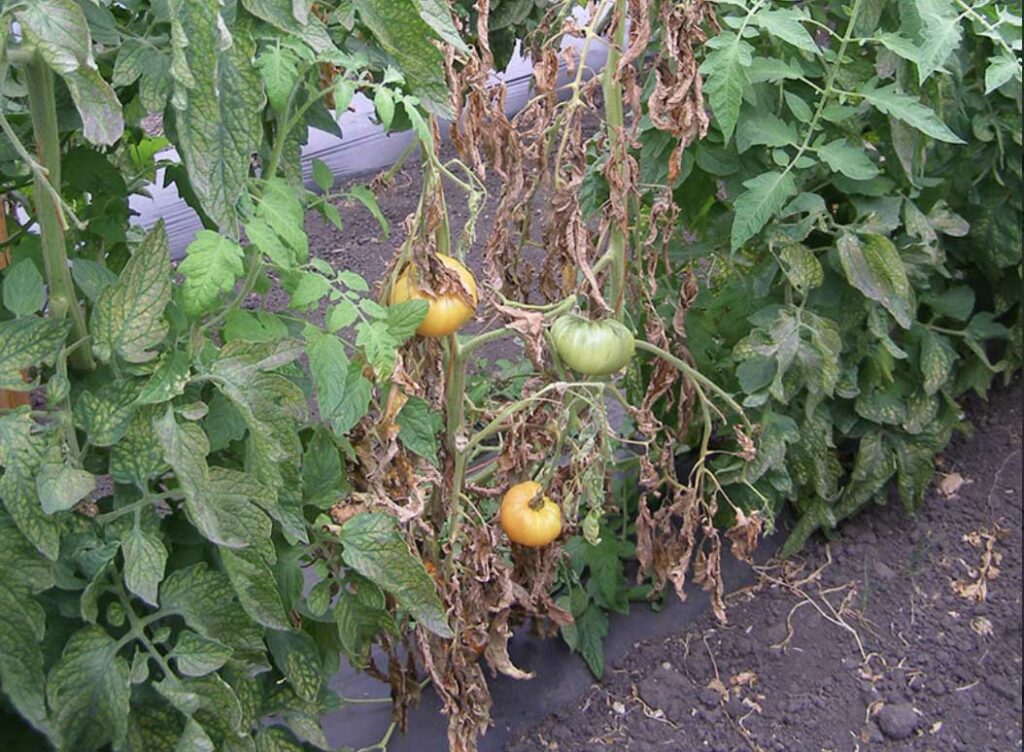
This disease infects tomatoes, peppers, eggplant, and deadly nightshade weeds. It thrives in 50–70-degree soil temperatures, low soil pH, and wet soil. It can spread by the wind, by root-to-root contact, and by infected tools, people, and soil. The spores can also survive in wooden stakes.
Symptoms

Fusarium crown and root rot cause yellowed and stunted tomato plants, rotting roots, premature leaf drop, and death. Chocolate brown lesions may girdle the stem. If the stem is cut lengthwise, it has a reddish-brown discoloration.
Treat
There is no effective treatment for Fusarium crown and root rot. Promptly bag affected plants and throw the bag in the trash. Be sure to get all the roots. Do not compost the plant.
Prevent
Plant tomato varieties with the code “FOR” on the seed packet or label. These varieties are resistant to this disease. If you grow heirloom varieties, graft them onto resistant rootstock. Keep your soil pH at 6-7. Remove plant debris after each season.
I wash and sanitize tools and wash my hands after handling a diseased plant to avoid spreading the problem. Use fresh strings and wooden stakes each year. I use metal tomato cages and sanitize them between seasons.
9. Powdery Mildew
Causes
Leveillula taurica, Oidium neolycopersicum and Oidium lycopersicum
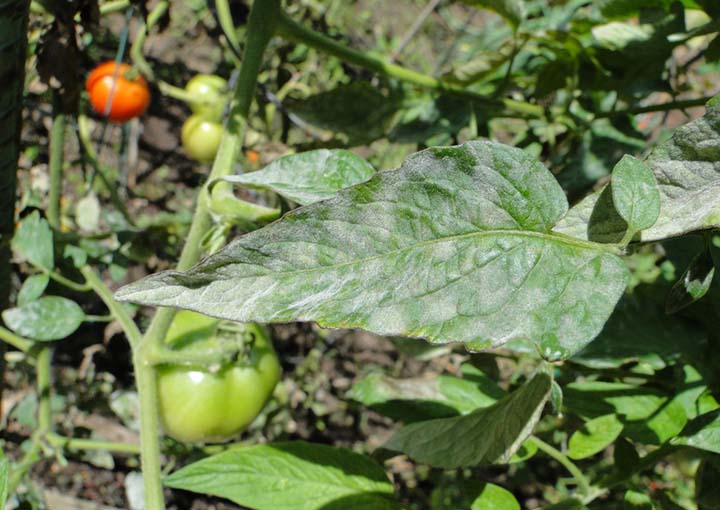
Powdery mildew is a disorder of leaves and doesn’t affect stems or tomatoes. While powdery mildew doesn’t usually kill the plant, it will reduce yields and lead to sunscald on the fruit. Spores travel long distances on the wind and land on a leaf, then enter the plant through the leaf stoma (pores).
Powdery mildew prefers cool to moderate temperatures and needs little moisture to germinate and infect a plant. However, it often appears when it is hot and dry.
Symptoms
Light green or yellow blotches appear on leaves. They are covered in a white powdery substance that is the spores grow on the blotches. The entire leaf becomes engulfed in the disease and turns brown but stays on the plant.
Treat
Treatment is usually not necessary. If the plant is becoming covered with powdery mildew, I use a fungicide with sulfur in it like Bonide Sulfur Plant Fungicide. I repeat it every seven days until two weeks before harvest.
Prevent
Remove weeds from the area around your garden, including tomatoes. Powdery mildew infects most vegetable plants. Remove plant debris at the end of the season. Plow your garden area to turn the spores under.
Plant resistant varieties. Plant transplants that are certified disease-free of powdery mildew. Use pruning, caging or staking, and proper spacing to enhance air circulation around the tomato plants.
Don’t apply too much nitrogen because the lush growth cuts down on air circulation and the new growth is especially vulnerable to powdery mildew.
10. Septoria Leaf Spot
Causes
Septoria lycopersici
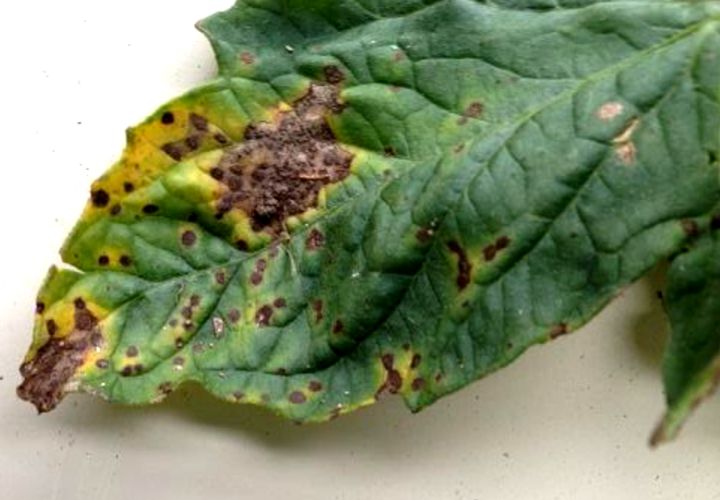
Septoria leaf spot prefers warm temperatures and high humidity. It stays in the soil and gets splashed up on the leaves by water.
Symptoms
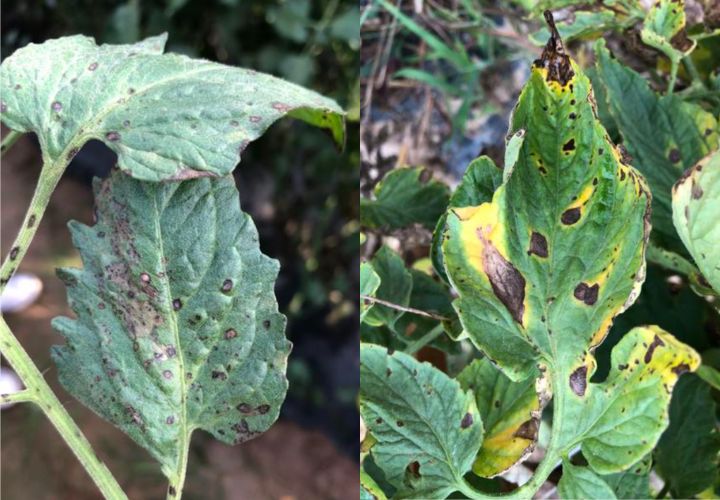
Septoria leaf spot develops on the lower leaves and progresses upward. The leaf spots are small (1/8-14 inch) brown spots that have tan to white as they age. Leaves rapidly fall off the tomato plant. Black fruiting bodies may grow in the center of the spots. Lesions may form on stems, pedicles, and other parts, but not the fruit.
This disease may be hard to distinguish from early blight, but the circles are lighter brown with Septoria leaf spot and do not have concentric circles.
Treat
If there are just a few leaves affected, remove them and put them in the trash. If many of the leaves are affected, I treat them with a copper fungicide like Bonide Captain Jack’s Copper Fungicide.
Prevent
Do not water overhead. Use drip irrigation or a soaker hose or pour water at the root zone. Remove all plant debris after each season. I keep weeds controlled as some act as a harbor of this disease. Make sure the tomato plants are spaced far enough apart.
Prune suckers off the stem. Once the plant is producing you can remove the bottom three to four sets of leaves. Trellising or caging helps prevent this disease. Do not work on wet plants because you may spread the spores.
Put down mulch after transplanting the tomato plants. I use about three inches of hardwood chips or straw. Rotate your crops and don’t plant another deadly nightshade plant for two years. Sanitize tools after use to prevent spreading spores.
11. Southern Blight
Causes
Athelia rolfsii

This spore favors temperatures of 77-95 degrees, poor air circulation, moist areas, and acidic soil. It infects plants from the ground up. Southern blight affects many different species of plants.
Symptoms
A brown or black lesion forms on the stem right at the soil line. Seedlings may fall over. The lesion may girdle the stem and kill the plant suddenly. White mycelium forms on the lesion in moist conditions and may extend up the stem quite a ways. After a few days, tan to brown round sclerotia form on the white mycelium. Other diseases have black or brown lesions, but nothing else has the distinct white mycelium followed by the tan to brown sclerotia.

If your fruit is in contact with diseased soil, it will develop sunken and slightly yellow areas that quickly look water-soaked and star-shaped. The fruit rots quickly and fills with white mycelium and the tan to brown sclerotia.
Treat
No treatments are approved for home gardens. Using ammonium nitrate instead of other forms of nitrogen when fertilizing may help.
Prevent
Plow the area you will grow tomatoes in under each fall so the spores are buried and cannot reach the surface. Do not water overhead. Remove sick plants and put them in the trash. Improve air circulation with pruning, staking, and appropriate plant spacing. Rotate your crops and do not plant things in the same family in a spot for two to three years.
12. Verticillium Wilt
Causes
Verticillium dahliae and Verticillium albo-atrum

Verticillium wilt lives in the soil and can stay viable indefinitely. The disease likes cool air and soil temperatures.
Symptoms
Verticillium wilt causes yellow V-shaped spots on the leaves of the tomato plant. The spots turn from yellow to brown. The symptoms start in the older leaves.
They progress up the plant so that the foliage dies, and the fruit remains small and with yellow shoulders. Verticillium wilt seldom kills the plants, but they do not produce as well.

Because of the loss of foliage, sunscald is a problem for tomatoes. Stems near the bottom of the plant will have a tan discoloration in the vascular system.
Treat
There is no treatment for verticillium wilt. Remove and destroy infected plants, including the roots.
Prevent
Plant resistant varieties of tomato plants. Rotate crops to a non-susceptible crop like small grain or corn for two years to reduce the inoculate in the soil. Wash and sanitize tools and wash hands after handling diseased plants and soil. Mulch around your transplants. Growing early maturing varieties will help to get higher yields of tomatoes in areas where this disease is a problem.
13. White Mold (Timber Rot)
Causes
Sclerotinia sclerotiorum
This is a soil-borne and wind-borne spore. It generally appears on tomato plants when they begin blooming. Spores germinate the best in temperatures of 59-70 degrees and high humidity.
Symptoms
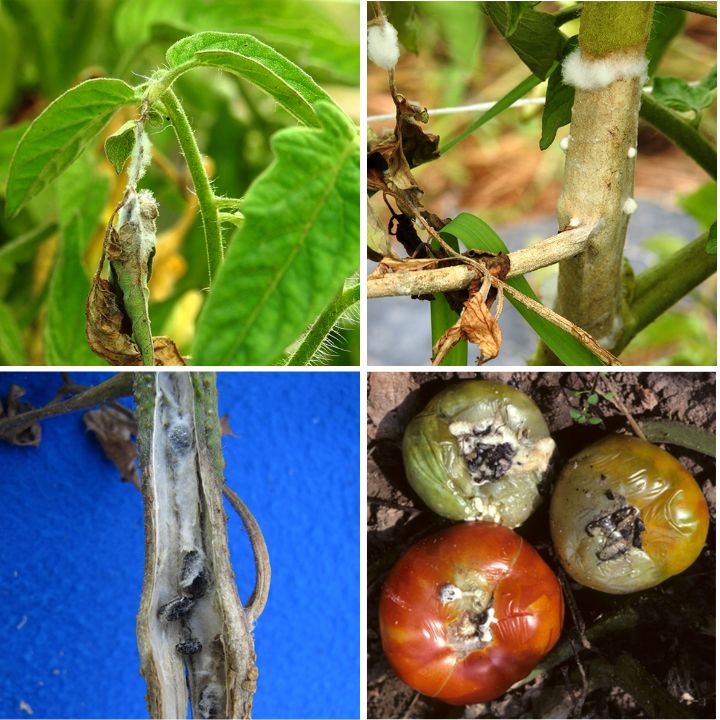
Water-soaked lesions appear on flowers and on the stem where spent flowers collect. White mycelium forms which are then covered with irregular black sclerotia. Stems quickly die and become bleached, white, and dry. Fruit gets mold at the part of attachment to the stem.
Treat
Preventive sprays of a copper fungicide like Bonide Captain Jack’s Copper Fungicide when the tomatoes flower can help control the problem.
Prevent
Because White mold is airborne, crop rotation and sanitation do not affect the presence of the mold. Spreading plant spacing can help by keeping the foliage dry can help. Subsurface irrigation can be useful by keeping the surface of the soil dry while feeding the roots the water they need. Till soil deeply every season to bury the spores.
14. Sooty Mold
Causes
Several molds cause the problem. They all grow on honeydew that is excreted by various insects, especially aphids. These molds do not damage the plant but block photosynthesis, which will reduce yields and eventually starve the plant.
Symptoms

A black powdery substance grows everywhere there is honeydew.
Treat
First, eliminate the insects that are excreting the honeydew. Until they are gone, the problem will just start coming back. Most of these insects can be eliminated by insecticidal soap.
Next, clean off the sooty mold. Use a solution of one tablespoon of liquid dish detergent (Ivory, Joy, not ultra formulas) to a gallon of water and spray the leaves well. Wait fifteen minutes and wash off the spray with a strong stream of water. Be sure not to damage the leaf or stem with the stream of water. You may have to do this every day for a week or so to get all the sooty mold off.
Prevent
Inspect your plants at least weekly for insect pests. As soon as you find a problem, treat it.
Caused by Water Molds
Water molds are similar to true fungi but are sometimes treated with different fungicides.
15. Late Blight
Causes
Phytophthora infestans
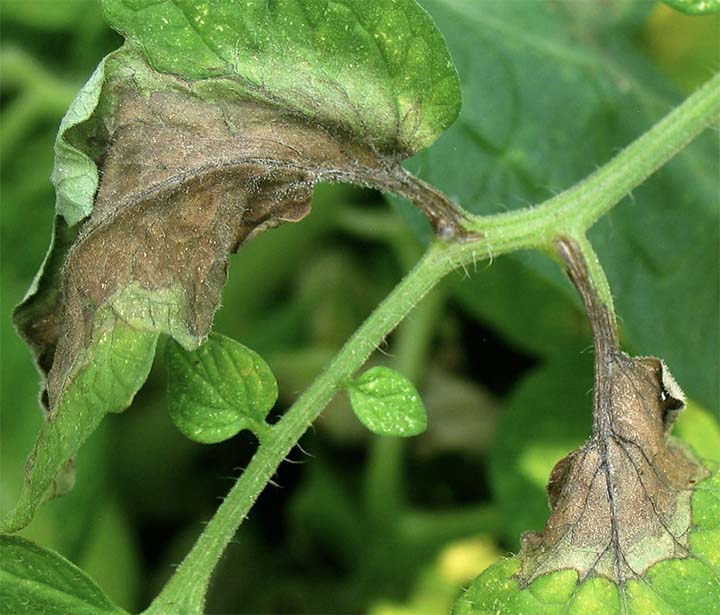
Late blight infects the stems, foliage, and fruit of the tomato plant. The same organism causes the blight in potatoes and is responsible for the Irish potato famine in the late 1840s. Late blight favors cool (60-70 degrees) and damp weather. Warm dry weather will stop the organism from spreading. Late blight spreads by airborne spores and through infected transplants.
Symptoms
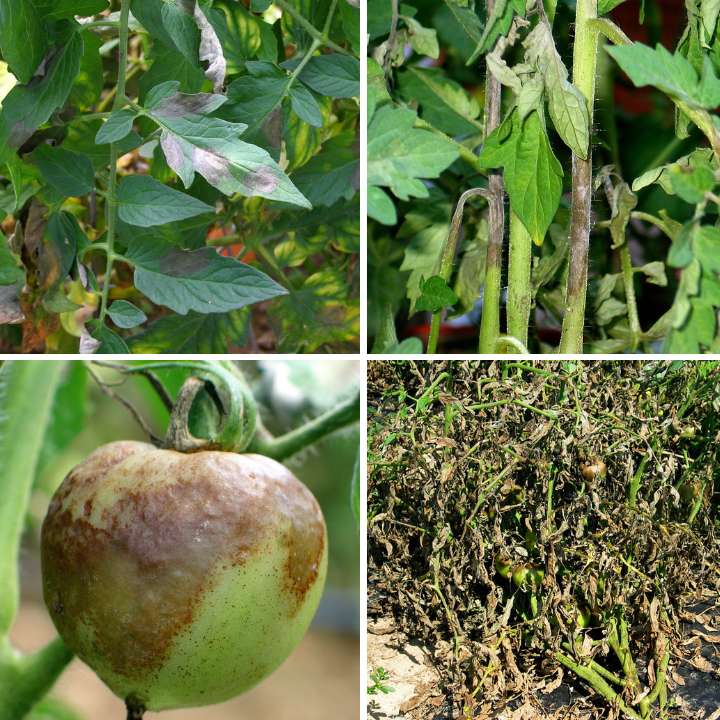
Late blight causes large dark brown blotches with gray edges on leaves. The blotches cross the leaf veins. Stem blotches are firm and dark brown and have rounded edges.
In tomatoes, firm, dark brown lesions occur and rapidly cover the fruit. Secondary bacterial infections may invade and make the fruit mushy.
This disease attacks fast and whole fields of tomatoes can become brown and wilted as if a frost hit them. During high humidity, thin powdery white fungal growth covers the lesions on stems, leaves, and fruit.
Treat
Treat with a copper oxide fungicide like Bonide Captain Jack’s Copper Fungicide. If late blight has been a problem in the past, use preventive applications.
Prevent
Plant resistant varieties. Plant only disease-free transplants. Keep leaves and stems dry by not watering overhead, don’t handle wet plants, and space plants, so the air circulation dries the leaves promptly after rain or dew.
16. Phytophthora Root Rot/Buckeye
Causes
Phytophthora parasitica and P. capsici

These water molds occur in most soil. Anytime there is water standing in the soil, these molds can infect roots and also fruit or stems in contact with the soil.
Symptoms
Brown lesions on roots in the ground. Often, the first indication of a problem is a slow-growing plant that will wilt and die in hot weather. Once most of the roots are girdled by their lesions, the plant cannot take up water and dies.
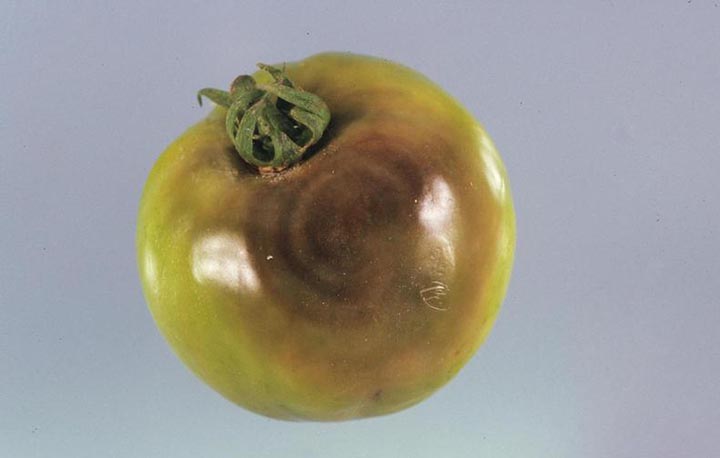
Fruit in contact with the wet soil develops tan or brown spots with concentric rings. This is referred to as buckeye rot. P. capsici causes greasy, purple-brown stem lesions.
Treat
There are no homeowner-approved methods of treating this disease.
Prevent
Plant tomatoes in well-drained soil and do not overwater. Avoid wide fluctuations in soil moisture. Rotate tomatoes and all deadly nightshade plants for one year after Phytophthora problems have occurred.
Caused by Bacterial Pathogens
There are many bacterial pathogens that affect tomatoes.
17. Bacterial Canker
Causes
Clavibacter michiganensis pv. michiganensis
Bacterial canker is primarily spread through infected seeds or transplants. The bacteria can survive up to three years on infected tomato debris and several months on infected equipment, tools, and stakes.
Symptoms
Bacterial canker symptoms differ between seedlings and older plants and may be difficult to diagnose without sending tissue to a plant pathology laboratory.
Seedlings
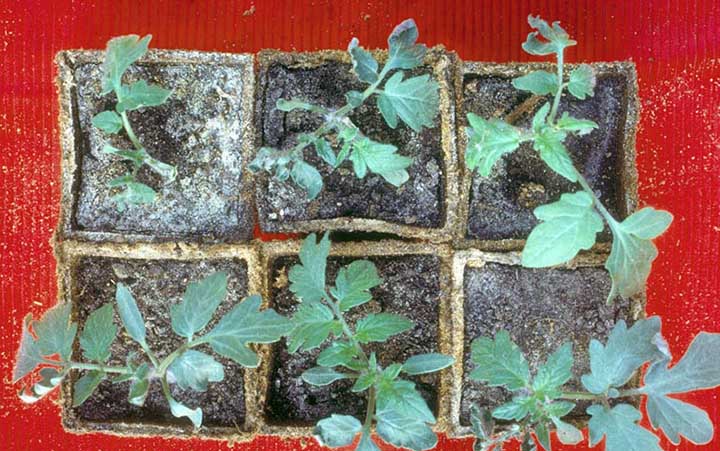
Small white spots appear on the leaves, along with curling and browning of leaf edges. The seedling wilts and dies.
Older plants
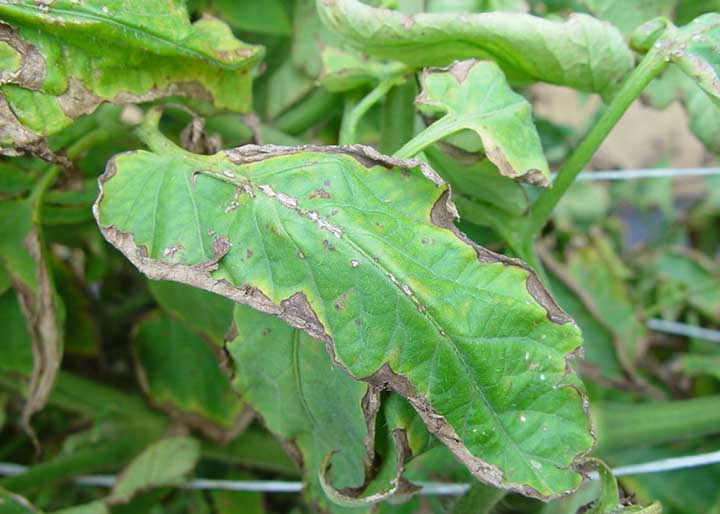
Yellow to tan spots form on the leaves between the veins. The edges of the leaves turn brown with a yellow margin. Lower leaves are affected first, often on only one side. Sometimes, the leaf veins turn dark and sink.
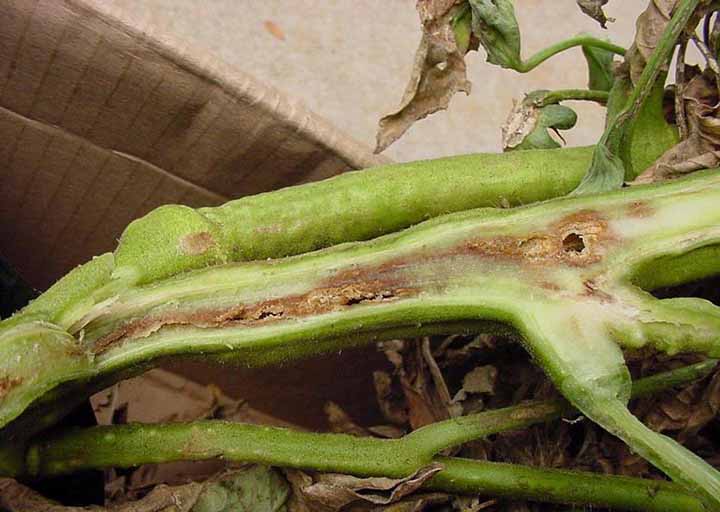
Stems split, forming long brown cankers. Yellow sticky stuff may come out of the stem when it is squeezed. Cutting the stem lengthwise reveals a brown discoloration inside.
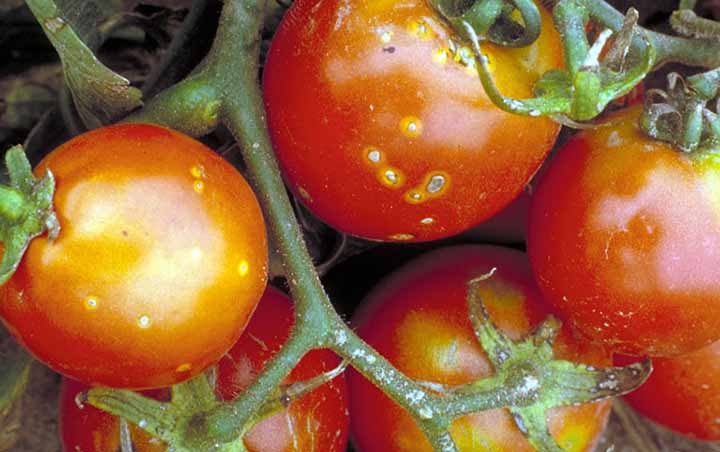
Fruit will get small, ¼ inch spots that are white with a tan or brown center, called birdeye. The surface of the tomato fruit may have the appearance of bird netting or marbling.
Treat
Remove leaves and fruit as soon as symptoms appear.
Prevent
Rotate crops for 3-4 years. Buy seeds from a reputable dealer. Inspect transplants for spots or discoloration before purchase and do not purchase any that have those symptoms.
Water in the morning and do not get foliage or stems wet. Space plants and stake or cage them to improve air circulation, so the plants dry sooner. Clean up all plant debris at the end of the season.
Sterilize pots, cages, stakes, and other items between seasons. Don’t use wooden stakes or use new ones each season. Use new string for trellises each season. Do not collect seeds from plants with this disease.
18. Bacterial Speck
Causes
Pseudomonas syringae pv. Tomato

This bacterium is generally brought in on contaminated seeds or transplants. It is spread when soil is splashed up on the leaves or fruit. Contaminated garden tools, hands, or wooden stakes can also spread it. Cool, moist weather favors the disease.
Symptoms
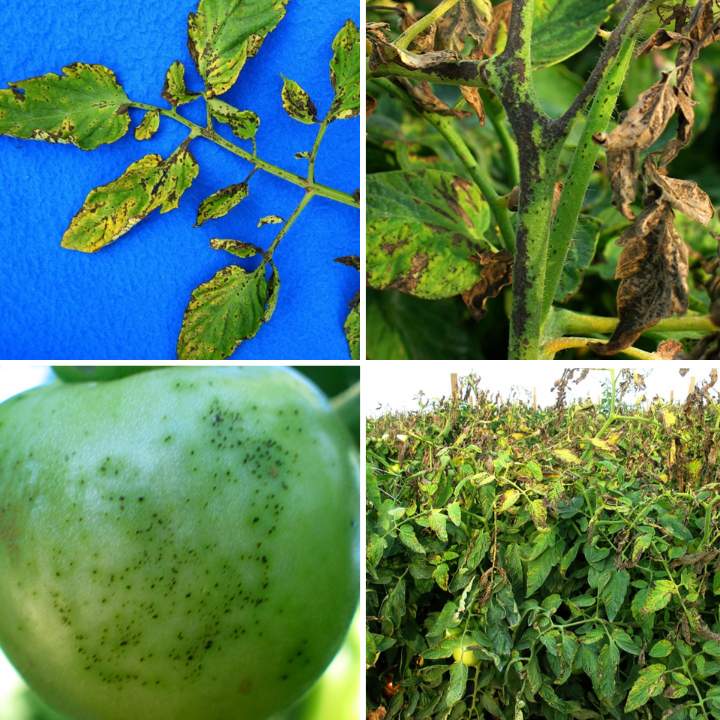
Leaf symptoms are small (1/8-¼ inches) black spots that are often more on the bottom of the leaf than the top. As the spots age, they sometimes develop a yellow halo. On fruit, the spots can be raised, flat, or sunken and are brown or black. They do not penetrate very far into the tomato. In green tomatoes, a darker green halo sometimes develops. On ripe tomatoes, a very faint yellow halo may develop.
Treat
Once tomatoes have bacterial speck, there is no cure. Do not eat tomatoes with bacterial speck because secondary infections of pathogens that make humans sick may happen. To prevent the disease, use a copper fungicide like Bonide Captain Jack’s Copper Fungicide every 10-14 days until the cool, moist weather stops.
Prevent
Buy only certified disease-free seeds and transplants. If you save the seed, treat it with hot (125 degrees F) water for 25 minutes before planting. Do not get water on the leaves or fruit and do not work on wet plants. Sanitize your hands and tools before using them. Dispose of plant debris at the end of the season.
19. Bacterial Spot
Causes
Xanthomonas vesicatoria, X. euvesicatoria, X. gardneri, and X. Perforans

These related bacteria prefer high temperatures, high humidity, and lots of rain. The infections are usually on infected seeds and transplants. They also survive in plant debris. Infected tools and hands can spread it along with soil splashing on the leaves and fruit.
Symptoms

Tomato leaves get small (1/8 inch) brown spots with yellow halos. The center of the spot often falls out, leaving behind small holes. Fruit gets small (1/4th inch) spots that are brown and scabby. They have a white, waxy halo. The spots do not rot.
Treat
Remove leaves with symptoms. Do not remove more than 1/3rd of the leaves on any plant. Do not eat fruit with bacterial spot. Badly affected plants should be removed and put in the trash. Do not compost the plants.
Prevent
Get seeds and transplants from reputable dealers. Inspect transplants for problems before buying them. If you save seeds, treat them with 125-degree water for 25 minutes before planting them. Do not water plants overhead. Keep leaves dry and remove plant debris promptly. Stake or cage tomatoes and leave enough space between them to promote air circulation.
Caused by Phytoplasma
Phytoplasma is an organism that resembles a bacterium but without cell walls or nuclease. Phytoplasma is a parasite and is spread by small leafhoppers.
20. Tomato Big Bud
Causes
Beet leafhopper transmitted viresence agent (BLTVA)
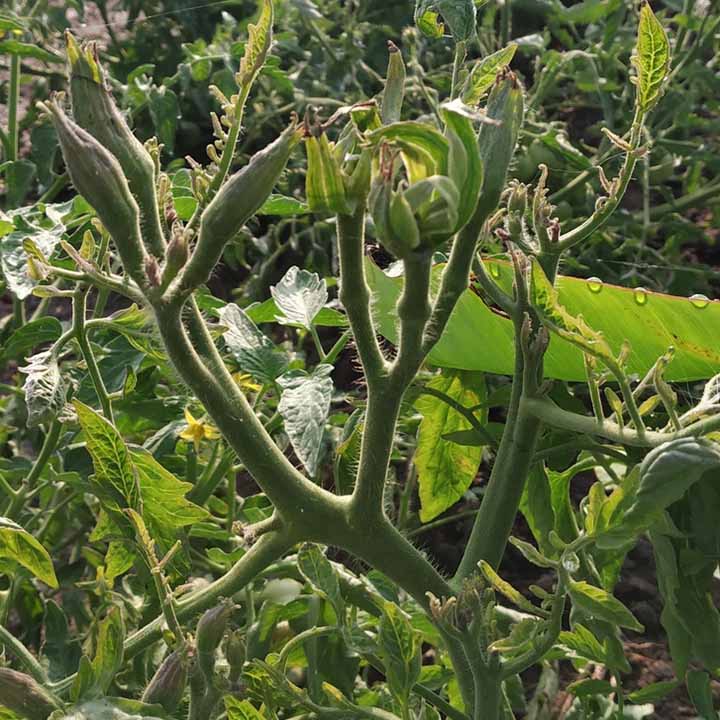
This disease is spread by the beet leafhopper, a small insect that sucks the sap out of the plant. When it does so, the beet leafhopper also injects saliva infected with the virescence agent into the tomato plant. This appears to be a relatively uncommon problem in most areas.
Symptoms
Large, swollen green buds that do not develop normally and do not set fruit. Infected stems look bushy because the space between leaves is smaller and the leaves are small. The leaves are distorted and yellow-green. Roots may develop on the stem in the air.
Treat
There is no treatment for tomato big bud. Remove affected plants and place them in a trash bag, then discard them in the trash.
Prevent
Keep weeds removed from the garden area. Dispose of plant debris promptly.
Caused by Viral Pathogens
A virus is a microscopic particle consisting of a segment of DNA or RNA surrounded by a protein coat. Viruses cannot replicate unless they infect a living cell.
21. Alfalfa Mosaic Virus
Causes
Alfalfa mosaic virus

This virus usually occurs in tomatoes grown near alfalfa fields. Aphids feed on the alfalfa and then can transmit the disease to tomatoes for a few minutes to hours, then cannot transmit it anymore. The aphids spread it when probing vascular tissue but not when feeding.
Symptoms
Alfalfa mosaic virus causes bright yellow splotches on the leaves of the tomato that have some mottling. The leaves eventually develop a bronze tone. The phloem tissue dies, including in the roots. Fruits become distorted and discolored. They have rings of dead tissue. Alfalfa mosaic virus kills the tomato plant.
Treat
There is no treatment for this virus. Insecticides that kill the aphids are ineffective in controlling the disease. Remove affected tomatoes and put them in the trash.
Prevent
Do not plant tomatoes near alfalfa. Do not let alfalfa grow as a weed near tomatoes. Alfalfa is sometimes planted for pollinators but will cause problems near the tomato plants. There are no resistant varieties of tomato plants.
22. Tobacco Mosaic Virus
Causes
Various Tobamoviruses including Tobacco mosaic virus and Tomato mosaic virus
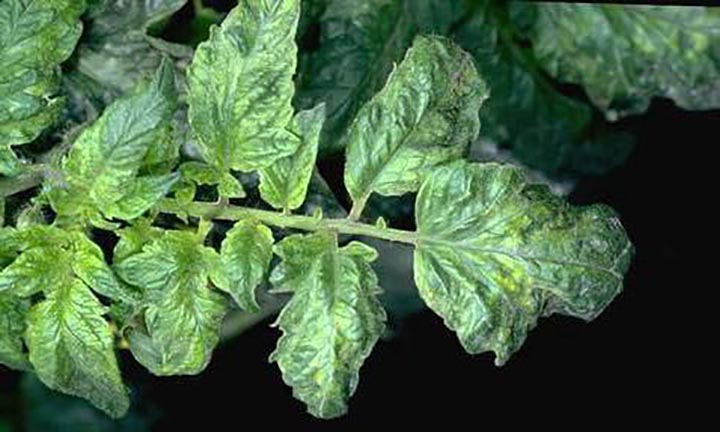
This virus comes from tobacco. It is almost exclusively transmitted by people who handle tobacco products and then handle tomato plants. These viruses may be transmitted by seeds, tools, and plant debris.
Symptoms
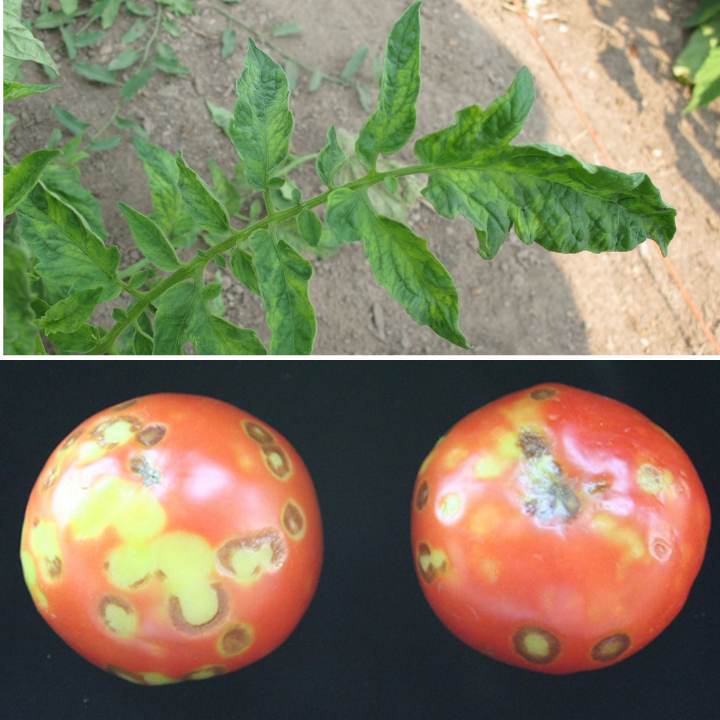
Light green, yellow or white mottling appears on the leaves. The leaves may also be stringy and distorted. In cool weather, shoestring like symptoms, that look like the strings vines use to hold onto a fence, develop. There may be dead places on the fruit, abnormal yellow coloring, small size, and abnormally shaped fruit.
Treat
There is no treatment for this disease. Fruit without necrotic spots may be eaten, but the yield and quality will be less than uninfected plants.
Prevent
Plant resistant varieties. Wash hands before planting or handling tomato plants. Do not handle tobacco or smoke while handling tomato plants. Use certified disease-free seed. Remove plant debris promptly. Sanitize your tools and equipment before using them.
23. Tomato Spotted Wilt Virus
Causes
Tomato Spotted Wilt Virus
This virus is transmitted by small thrips that bite the plant and transmit the virus. Infected tomato plants may serve as a source to infect ornamental plants and vice versa.
Symptoms
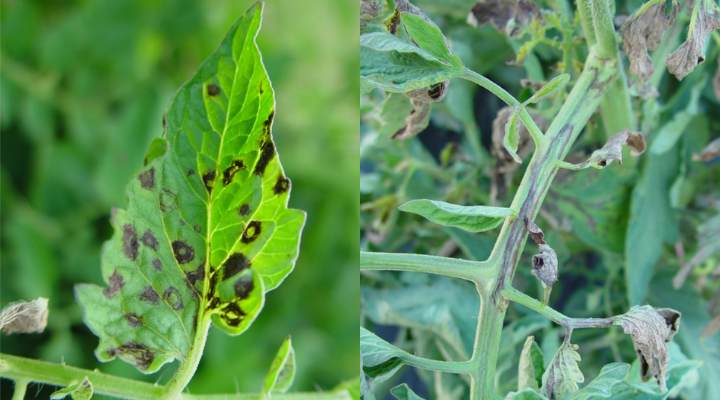
Young leaves develop a bronzed or purplish appearance and then brown necrotic spots. Spots with normal centers are characteristic of the disease. The leaves may become cupped downwards. Some of the tips may die back. The leaves may appear wilted.
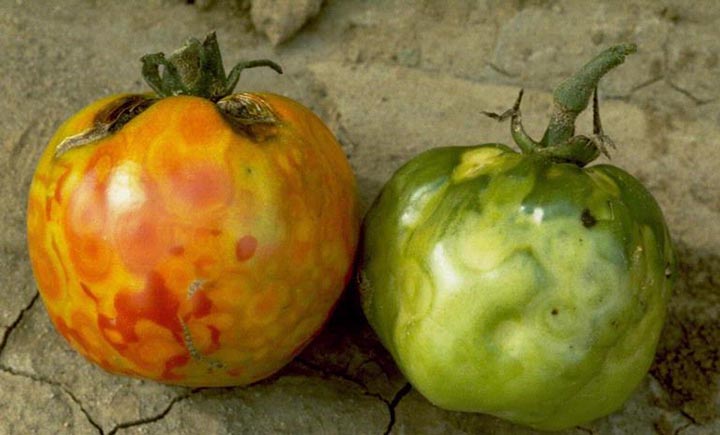
On ripe fruit, yellow splotches and spots appear which often have concentric rings. Green fruit shows raised concentric rings that are brown.
Treat
Once the tomato plant has this virus, there is no treatment. Remove the plant and put it in the trash.
Prevent
Plant resistant varieties. If you grow varieties that are not resistant, control thrips on them. Control weeds around the tomato plants. Promptly remove plant debris every season.
Physiological Disorders
These problems are not caused by pests or diseases, but by physiological processes in the tomato plant.
24. Blossom End Rot

Causes
Lack of calcium in the fruit. There may be plenty of calcium in the soil, but it is not being brought to the fruit in sufficient quantities. Calcium is brought to the fruit and leaves when they transpire (loose water via evaporation). Since leaves transpire more than fruit, they get more calcium. Only if there is calcium left over will it go to the fruit. Situations of high or low relative humidity and high wind limit transpiration so it can cause blossom end rot. Inconsistent moisture, damage to the plant’s roots, cold soil, waterlogged soil, and excesses of ammonium nitrate, potassium, and magnesium can all limit calcium uptake.
Symptoms
The tissue on the blossom end of the tomato breaks down and rots. Sometimes, the skin may look okay but when the tomato is cut the interior is rotted. Secondary infections can spread the rot to the whole fruit.
Treat
Once fruit has blossom end rot there is no treatment.
Prevent
Maintain consistent soil moisture. Use a fertilizer that uses nitrate rather than ammonium for the nitrogen source. Grow varieties that are tolerant of low calcium. Use a soil test to determine soil calcium and add it if necessary. Do not over-fertilize. You can read my post to know how to fertilize tomato plants. Excess nitrogen causes lots of leaves to grow which keeps the fruit from getting adequate calcium. Keep the soil pH between 6.0-6.5. Mulch around the tomato plants to conserve soil moisture. Remove damaged fruit promptly.
25. Catfacing

Causes
Cold temperatures during flowering and wild temperature differences between night and day temperatures increase the possibility of catfacing. In some cases, excessive nitrogen or excessive pruning can cause the problem. If thrips damage the flower, catfacing may occur.
Symptoms
A tomato is considered catfaced if the blossom scar is enlarged or perforated. Most catfaced tomatoes grow extremely distorted with many lobes.
Treat
Once a tomato is catfaced, there is no treatment. Remove these tomatoes promptly upon discovery.
Prevent
Plant varieties that are resistant to catfacing. Many heirloom varieties are more prone to catface. Avoid excessive pruning and excessive nitrogen. Don’t plant tomato varieties outside too soon.
26. Fruit Cracking
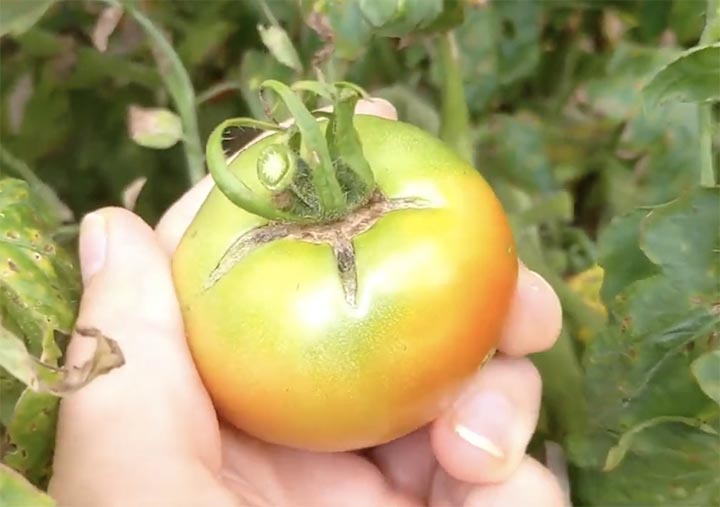
Causes
Fruit cracking is caused by periods of drought followed by periods of high moisture. The fruit grows faster than the skin can expand, leading to cracks around the stem.
Symptoms
The fruit cracks on the stem end. The cracks can radiate from the stem or form concentric rings around the stem.
Treat
Pick the tomato immediately and let it finish ripening inside. Discard tomatoes that have a sour smell or ooze fluid from the crack.
Prevent
Maintain consistent soil moisture. Mulch around the tomato plants to conserve soil moisture. Plant varieties that are resistant to cracking.
Sanitizing Your Tools and Hands to Prevent Disease Spread
Almost every tomato plant disease can spread on dirty hands and equipment.
Wash your hands with soap before starting work on plants and after handling diseased plants or plant debris. Wash your tools and sanitize them each day before you start work and after using them on a sick plant.
Soak the tools in a solution of one part bleach and nine parts bleach for thirty minutes. Rinse the tools clean. This may seem like a lot of trouble, but you will wish you had done this when diseases spread throughout your tomatoes and other garden plants.
Finding Disease-Resistant Varieties of Tomatoes
Many varieties of tomatoes both determinate and indeterminate varieties are resistant to different diseases. These disease resistances are listed on the label of the tomato or in the seed catalog description. The letters after the name mean the following resistances:
- “V” is Verticillium wilt
- “F” is for Fusarium wilt
- “FF” is for Fusarium wilt races one and two
- “FOR” is for Fusarium crown and root rot
- “N” is for nematodes
- “T” is for tobacco mosaic virus
- “A” is for Alternaria (all the species)
- “TSWV” is for tomato spotted wilt virus
An example is Celebrity VFFNTA hybrid, which shows this hybrid is resistant to Verticillium wilt, Fusarium wilt races one and two, nematodes, tobacco mosaic virus, and Alternaria. The variety is not resistant to Fusarium crown and root rot, or tomato spotted wilt virus. Cornell University maintains a website with an up-to-date list of tomato varieties and what they are resistant to.
Final Verdict
In conclusion, tomatoes whenever you are growing them in pots or in the garden, are subject to a wide range of diseases. The best way to prevent them is to plant resistant varieties, keep the garden free of plant debris, water with drip irrigation or a soaker hose, and do not get the stems and foliage wet when irrigating.
In addition, harvesting your tomatoes as soon as they are ripe keeps many diseases at bay. Sterilize your tools and wash your hands after handling a sick tomato plant to avoid spreading the disease. Never compost a sick plant.
If you do these things, you may still have problems with some diseases, but it can reduce the number of infected plants dramatically.

